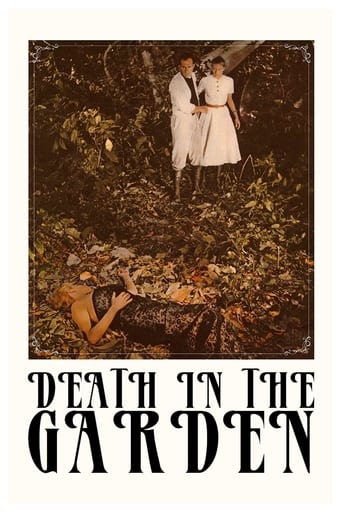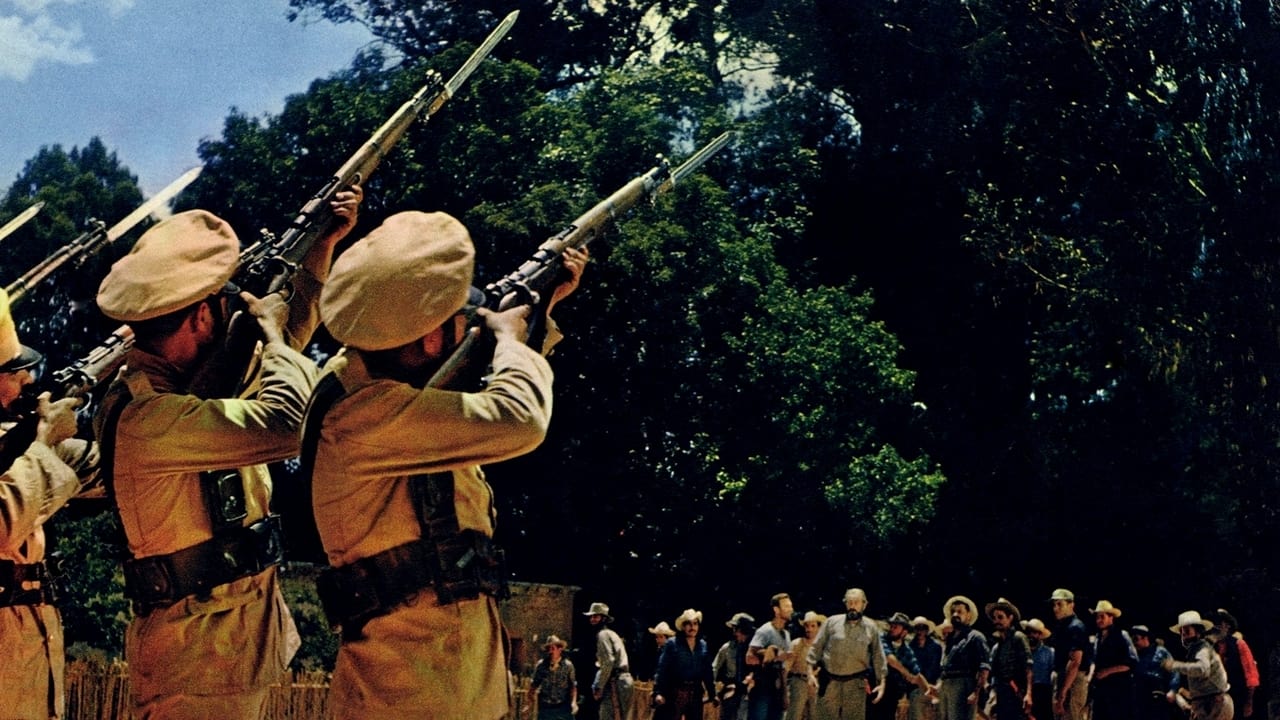Bob Taylor
I often turn to the Time Out Film Guide, to see what they think of films... They got it wrong for this one: "Its garish, vicious action beats Sam Fuller at his own game". Well it does no such thing. This is sub-par Bunuel at best. The first part, set in the little town in Mexico is easily eclipsed by Treasure of the Sierra Madre, a much funnier and tougher film. Just think of the interplay between Bogart, Walter Huston and Tim Holt and grimace at the clunky efforts of Marchal, Vanel and Piccoli. From a John Huston classic, we pass to a whimsical jungle story that Howard Hawks could have told with much better pace and wit (I think of Hatari!). Oh the waste of all these talented people.Simone Signoret has a thankless part of a prostitute (which she played much better in Dédée d'Anvers), a misconceived part that does not fit in the story very well. Piccoli cannot play a priest and should have known better than to try. He is much better as a libertine--he played Sade in La voie lactée. Gérard Philipe would have been much better as the priest. Marchal is no great shakes but at least fits the part. He reminds me a bit of Stewart Granger. Vanel is somewhat at home as the old prospector; at least he had often played action roles.
craig hill
Bunuel's Garden of Eden revisited moves in reverse from the hell of present day back to the Garden en route to the "next life", where the survivors of the Garden of Death expect a better world.The five escaping through this Garden are (1) the modern evil "Adam" (Chark) who, in a film first, flips the bird to the military, then roughs up (2) The Father for intervening to protect (3) his deaf mute daughter ("Eve"); (4) the handsome Priest/Savior, acting with the authority of a modern corrupt God on Earth taking the side of power and wealth over the oppressed; and (5) the well-named Djinn, Demon Temptress. Examples how well the story works within this paradigm:*The Father explains to his daughter (Eve) his plan to take her with him in a return to Heaven (France), where miracles will occur in ear doctors' offices. *Adam is (otherwise inexplicably) taken into the chapel where he is forced to kneel before the Savior/Priest before being taken in for interrogation for robbing the bank.*The Savior refuses to try to raise the dying rebel from his death in the dungeon despite Adam's pleas, instead offering dogmatic prayer which the savvy rebel bitterly rejects.*Just to make sure we see the extent of the "Fall" under the rule of Christianity, justice is delivered against the weak and the dying by the goons of the corrupt in firing squads. *The Savior barges in on Eve while she is half-dressed looking for The Father to convince him to surrender to the corrupt military, and sacrifice himself to save the innocent (his own role in the Bible), even tho The Father is innocent as well. He asks in response to the Savior "What will become of my daughter?" The Savior's conflict of interest becomes clearer in the Garden as he tries to usurp The Father and take his place in the relationship with Eve. The Savior (inconsistently, as in the Bible) saves The Father by pretending to be the lover of the demon Djinn. *The Father grows increasingly batty throughout the film, falling in love with the demon Djinn and suffering from a head wound. Bunuel suggests the oxymoron of the single male parent/creator is evidently losing his mind. *On the boat to the Garden, the Savior asks Adam to drop him off at a native village. Adam rebukes him, telling him he would become their taskmaster. The Savior replies he would save their souls; Adam counters he would lead them to their exploiters. Clearly Bunuel paints the Savior enjoying zero moral authority in a society where he is worshiped while he works for the benefit of the wealthy. *As soon as he steps off the boat, walking toward the Garden, the Savior loses his power of authority to The Father---because the Old Testament story of the Garden predates him.*Eve's hair is tangled in the vines of the Garden; The Father rescues her. Adam picks up on her need for care, protecting her asleep in the rain by placing his hat over her head, in a triptych where we see Eve with her head leaning on his right thigh, in the center the rifle as phallus (Adam, according to the myth, being the physical father of us all) standing erect between his legs, with the Djinn leaning on his left thigh, whom he does not protect. *The Father is dying and losing his senses, eventually deciding to kill everyone but Eve, giving up on Heaven as he burns his images of it in the flames warming them in the hellish Garden, its tinder the pages of the Bible torn out by the Savior, who then preaches a parable about (Easter?) eggs no one pays attention to, ending by inexplicably referring to his mother. There is no better image underscoring that this is Bunuel's take on the Garden of Eden and modern Christianity than when the Savior looks directly into the camera as he informs us he is the son of Mary.*The Father in despair explains to Djinn they're all guilty of the sins that led them to the Garden and accordingly there is no redemptive future to hope for. *Adam kills a serpent, for food, which only the creatures living in the Garden eat. He then discovers a horn of plenty, the crashed plane, as if a tree of life filled with death, providing them with food and clothing, even extravagant evening dress. *They discover the river crossing to "the other side", the Savior proclaiming it a miracle from god, the rest wise to his lack of authority, disbelieving and disagreeing with him. *Eve shows jewels to the Savior she found in the wreckage, as shiny as an apple. He seizes them from her, informing her he is taking her Father's place, giving her his watch in exchange, which she appropriately considers a worthless excuse for his theft. *The Father throws his own wealth in the water, the bag of diamonds he gave to Djinn, telling the Savior their deity is punishing them all. The Father then proves it. The Djinn puts on black evening wear (as if for her funeral), which Adam tells her prepares her for her next life on the other side of the river. The Father unleashes his Old Testament wrath, shooting and killing first the Djinn he had loved, then the Savior with his usual ineffectual pleas.*Eve convinces Adam not to kill her Father, who tries to stop Adam from taking Eve out of the Garden. In self-defense, Adam kills The Father, escaping his wrath by fleeing with Eve to the other side.The otherwise odd ending of this film makes perfect sense as Bunuelian religious allegory.
reader4
Rarely have I been so disappointed in a film. Bunuel *and* Simon Signoret? What could be better? I have seen many of Luis Bunuel's movies, and consider myself a fan. From his first, Un Chien Andalou (1929), to his last, That Obscure Object of Desire (1977), I have seen more than half the films he ever made.Death in the Garden is undoubtedly the worst I have seen. There are three words for this movie: Violent. Pointless. Boring.There is virtually no surrealism in the film whatsoever. And absolutely none of Bunuel's unique humor. It consists mainly of two things: people getting shot, and people walking (or running) around.The film is incredibly violent. The vast majority of the action is people being shot. It is not gory by the standards of the twenty-first century, but it sure is for the fifties, perhaps more so than any movie up to its time.There are two good things about the film. First, and to my surprise, it is shot in absolutely gorgeous Technicolor. The scenery is breathtaking, and Edward Fitzgerald's sets are also quite eye-catching.Second, Simone Signoret has never looked more beautiful. Nor more sexy. I found it interesting that somehow they managed to make her look vaguely South American, although I couldn't put my finger on exactly how.Sad to say, her outer beauty is nullified by her inner personality. She is a monster. She is motivated solely by greed, completely devoid of any human qualities such as warmth or compassion. She doesn't care about anyone else, nor anything except her own advancement and security.The only thing I really liked was the interview with Victor Fuentes on the DVD. He is extremely articulate, and his viewpoint is continually interesting. He mentioned The Wages Of Fear (1953), which I immediately thought of as soon as the movie started. However, to compare Death in the Garden with Cluzot's movie in any respect except the setting is an insult to the latter.If it had not had Simone Signoret in it, I would have turned it off after the first ten minutes. As it was, I watched it till the end, but I am not particularly glad I did so.Want to see a great Bunuel film from his Mexican period? Watch The Exterminating Angel (1962). Want to see a great Simone Signoret movie, where she's every bit as beautiful and almost as sexy as this one? Catch Les Diaboliques (1955). I can't think of any reason for even hard core fans of Bunuel or Signoret to watch this one.
lastliberal
It's only now that we are able to enjoy many of the films Luis Buñuel made during his time in Mexico. Sure, it won't rank with his classics like Le Charme discret de la bourgeoisie or Cet obscur objet du désir, but this South American action thriller has a charm all it's own, Make no mistake, La mort en ce jardin, also has pure Buñuel elements to it, especially in the third act.Shark (Georges Marchal) and Djin (Simone Signoret) are certainly the most interesting characters in the first act. Shark may be a lout (Shut up Bible thumper!), but his skills come into play later. Djin is just hot.Great action in the jungle and a beautiful setting in Mexico.


 AD
AD



